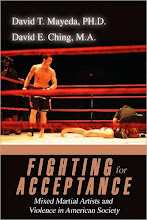 Before jumping into a Marxist analysis of MMA, I wanted to follow up on my previous opinion piece posted here a few days ago, titled “Theorizing Violence in Sport: The Case of Mixed Martial Arts (July 23, 2010).” The essay gained a little bit of traction across the MMA blogosphere discussed on BloodyElbow, Sherdog, and the UG. Not a terribly big deal, but I believe responses were a bit unfair to Zuffa, LLC and the UFC specifically, both in the receptive headlines and general discourse. My original article did not mention the UFC too much more than Strikeforce. However, it seemed the UFC was presented as the sole MMA organization to be held responsible, as opposed to an example of a profitable organization that may want to foster safety measures beyond its current organization.
Before jumping into a Marxist analysis of MMA, I wanted to follow up on my previous opinion piece posted here a few days ago, titled “Theorizing Violence in Sport: The Case of Mixed Martial Arts (July 23, 2010).” The essay gained a little bit of traction across the MMA blogosphere discussed on BloodyElbow, Sherdog, and the UG. Not a terribly big deal, but I believe responses were a bit unfair to Zuffa, LLC and the UFC specifically, both in the receptive headlines and general discourse. My original article did not mention the UFC too much more than Strikeforce. However, it seemed the UFC was presented as the sole MMA organization to be held responsible, as opposed to an example of a profitable organization that may want to foster safety measures beyond its current organization.Additionally, I was careful not to explicitly state that any MMA organization (UFC, Strikeforce, whichever) should be responsible for investing in a kind of minor league, MMA farm system. From the final paragraph in my original piece: “Perhaps this means larger MMA organizations like the UFC and Strikeforce need to consider investing their profits in smaller organizations to help improve an infrastructure that bolsters safety precautions…” Considering broader investment in safety-based infrastrcutre across smaller organizations is not radical by any means.
A good example of a model would be the WEC before the folks at Zuffa decided to cut the heavier weight classes. Under the Zuffa umbrella, the WEC ostensibly served as a farm system for fighters in multiple weight classes (155lbs – LHW) who could matriculate into the UFC when their talents warranted promotion. And with the WEC under the Zuffa banner, it was (and still is for the WEC fighters in lighter weight classes) understood the strictest, most thorough safety precautions would be taken, in large part because the parent company (Zuffa) could afford them.
If we are going to focus on Zuffa, this could mean the Fertitta brothers, Dana White, and company identifying smaller, regional MMA organizations with whom they would like to forge formal partnerships and investing in their organizational development (e.g., promotional strategies, fighter recruitment). This would also mean enforcing the most thorough medical/safety precautions that may frequently exceed state regulations. In return, hopefully the best fighters would gravitate towards those farm organizations and safely progress to the UFC.
No model is perfect. Tensions could emerge between whatever parent MMA organization is running the show and the smaller feeder organizations over any number of issues. Mapping out and implementing such a plan would take years, but prominent, successful organizations have vision and make long-term organizational plans. One central focus (and the one with which I am obviously most concerned) is broad-based prevention. This was never and is not now an alarmist response to two deaths in sanctioned MMA. This is a public health-type prevention response, arguing those tragedies are important, and long-term, it would benefit the industry if wide-spread measures were taken to prevent/minimize future deaths and major injuries.
If we can agree that Zuffa provides the best medical precautions, why not work to expand that infrastructure? Then the issue of cost comes up, and presumably, Zuffa shrunk the WEC at least in part because having so many weight classes was not fiscally profitable, leading me to my next point…
A Marxist Interpretation of MMA
In a developed society like the United States that leans heavily towards capitalism and the free market, a highly successful private enterprise is obviously not responsible for ensuring other, smaller companies are implementing any level of worker safety. As noted in the original essay, although the bigger MMA organizations rely on the smaller ones for worker development/recruitment, there is to my knowledge no formal relationship between them. On the contrary, MMA organizations big and small may even identify one another as competition and have antagonistic relationships. And that is part of the crux in this discussion (sorry, what follows is gonna get a bit lengthy and lecture-ish).
If applying a very Marxist viewpoint, in a for-profit company, those at the top will never pay its workers their full value, let alone workers outside of their organization. In fact, capitalist companies world-wide know that the best way to maximize profit is not via sales (though sales are necessary), but via under-paying labor. Hence, within a capitalist system, the proletariat (fighters) will always be at odds with the bourgeoisie (promoters/owners), as maximizing worker cost minimizes profit margin. Thus, it is not in any company’s best interests financially to support workers, especially workers industry-wide.
Sticking with the Marxist lens, the difficult part for fighters is so many have what Marx called “false consciousness” – they genuinely believe that to a large degree they benefit from more than they are harmed by the bourgeoisie, industry, and social structure. Not only does the promoter pay the fighter, but through the industry, fighters report learning positive values (e.g., discipline) and attain a certain status (e.g., celebrity, alpha male). This status coupled with financial compensation helps fighters cope with a sense of alienation from their own bodies. Their own bodies become defined as tools for the MMA industry, in this case tools valued for their ability to destruct other fighters and absorb pain in the short-term, rather than healthy bodies over time.
And while previous research shows that fighters are keenly aware of their own exploitation (see Loic Wacqunt’s qualitative work with boxers), fighters will inevitably invest their efforts in fighting each other rather than the power structure. Supporting the company line and defeating a fellow fighter yields far more social rewards now than working with fellow workers to secure worker rights years from now (never mind trying to do so individually). And management knows this. Keeping workers invested in the company and divided among themselves means there is no collective working-class resistance to conquer.
Hence, even when the most socially powerful fighters like Randy Couture challenge management, the collective silence of all other fighters vastly outweighs Couture’s protest, and eventually he is compelled to return if he wants to continue practicing his craft at the highest level. And high-level, well-compensated fighters, like Couture, Brock Lesner, and Chuck Liddell, are portrayed almost as a norm, even though they are outlying exceptions with regard to worker compensation across the MMA landscape.
The other issue at hand for Marx is the broader public, or in this case, MMA fans. Capitalism functions more efficiently when workers as a whole have leisure time to re-charge (hence, we have weekends, holidays, vacation). Sport functions in society for workers as a site where one can have a reprieve from work, only to go back to work without complaining about it. The MMA industry is built largely from the reality that much of our society values and has commodified violence as a form of entertainment.
Thus as capitalist enterprises, MMA organizations know they can increase profits not only by increased gate and pay-per-view sales, but also through advertising deals, DVD sales, clothing sales, and so on. And as long as enough of the larger society values violence as a form of entertainment, the broader public will support the industry that creates this manifestation of violence, but not the workers that enable the industry to run.
If workers outside the MMA industry value quality MMA fights but don’t want to pay unreasonable costs to watch them, they are not going to seriously advocate for the fighters’ rights. Doing so would increase MMA company costs and in turn costs of MMA pay-per-views, tickets, and merchandising. Consequently, those who utilize their bodies as labor are resigned to (in this case literally) fight for themselves and against one another. They don’t get broad-based, radical support from the bourgeoisie, each other, or the broader public.
One could reasonably argue, fighters engage in fight sport as a personal choice, and that is ultimately true, but it is true to different degrees for different people. People are born with vastly different life chances. It is no coincidence that such a high proportion of boxers from different ethnic demographics have come from very working-class backgrounds over the decades.
And while MMA currently has a larger proportion of fighters from middle-class backgrounds, one can go back to the way our society values masculine violence as a form of entertainment. This will inevitably influence heavy numbers of males to pursue a pro MMA career, often at the expense of other, more likely and lengthy vocational paths. And back to the issue at hand, sacrificing the more likely career path means not crossing the boss once in the MMA industry.
With all this in mind, who is going to support the fighters, and not just the ones that already make six figures?

Blogosphere








Recently I visit your blog and got some useful information regarding martial arts supplies & Sparring Gear.Your blog is a very good source for Martial Arts Supplies and other type of arts and am agree with your thoughts that's Martial art is one of the best ways for self defense and can be learnt very easily. Once you know the Techniques involved in Martial Art you will be able to protect yourself from any danger.
ReplyDeleteVery Helpful information in your blog Martial arts gear canada provide uniforms, safety equipment from all over in Canada.For More information http://www.gorillagear.ca/protective-fight-gear
ReplyDeleteguys i have something for you if you are wondering to purchase some boxing equipments then pease cick here Martial arts gear canada
ReplyDelete